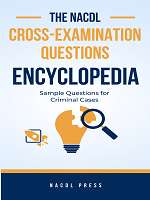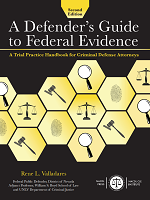Access to The Champion archive is one of many exclusive member benefits. It’s normally restricted to just NACDL members. However, this content, and others like it, is available to everyone in order to educate the public on why criminal justice reform is a necessity.
In all criminal prosecutions, the accused shall enjoy the right to a public trial.
— Sixth Amendment, U.S. Constitution
Every criminal defense lawyer knows that a core aspect of the Sixth Amendment — giving a defendant the right to a public trial — is now nearly extinct. Exercising the right to test the government’s evidence in a trial is now burdened with such extraordinary risk that even those who are wholly innocent rationally and wisely enter guilty pleas. The Supreme Court recently noted that “criminal justice today is for the most part a system of pleas, not a system of trials. Ninety-seven percent of federal convictions and ninety-four percent of state convictions are the result of guilty pleas.”1
Most defense lawyers routinely agonize with clients who genuinely doubt their own guilt and many others who unequivocally assert innocence as they grapple with the choice of a defined and limited penalty versus the near certainty of a geometrically enhanced term of imprisonment if they seek the judgment of a jury of their peers. All of us have stood beside a client who follows the script in a plea allocution, asserting that no one has “threatened or coerced” the plea, knowing full well that the entire process is inherently rife with the coercion of vastly enhanced penalties after a trial. How did we get to this place? How did the criminal defense function evolve to the point where even the best, most talented and fearless lawyers have come to recognize that plea negotiation and plea persuasion are defense counsel’s most important function? The answer is clear: it is the trial penalty. It is the outrageous tax that is imposed upon the accused who dares to seek a trial.
The trial penalty is a product of many factors that imbue prosecutors with virtually unbridled authority to punish criminal defendants disproportionately simply for exercising a fundamental constitutional right. It stems from prosecutorial control over the charging function — the ability to add, increase and stack multiple counts that may be applicable to a single criminal act or enterprise. It is augmented by a vast array of tools that enable the prosecutor to increase the potential penalty at each stage of the process at which the accused fails to capitulate. Tools at the prosecutor’s disposal include the ubiquitous availability of mandatory minimums and enhancements; the option to introduce extraneous evidence to poison the court and invoke additional penalty triggers; and the confidence that courts will sentence slavishly tethered to guidelines — even after they have been declared advisory. The toolbox also contains the calculated use of undercover agents and cooperating witnesses to artfully manipulate a target into deeper criminal exposure; and the nearly limitless use of cooperators and informants who are themselves induced by the trial penalty to exaggerate and even fabricate evidence incriminating to an accused person who asserts the right to a trial.
The resulting injustice is pervasive. We have all seen it and experienced it in our practices. We see it whenever individuals who believe in their innocence throw in the towel to accept a few months in prison rather than risk 10 years. We see it when a person has the courage to assert his right to a trial and ends up with a draconian sentence that is 10 or 20 times greater than the plea offer.2 And we see it when the least culpable defendant invokes her trial right and receives a sentence that far exceeds that imposed upon more culpable co-defendants — simply because she had the audacity to take the case to a jury.
Of course, most acknowledge that there should be some discount for sparing the government the cost of a trial. Indeed, for those who are in fact guilty, consideration for acceptance of responsibility is only fair. And some increased penalty for failing to acknowledge obvious guilt is not unjust. But when the tax imposed for exercising a right to a trial is excessive, that is fundamentally unfair. When a prosecutor concludes that justice will be served by sending a person to jail for one or two years but then seeks 5, 10 or 20 years — just because the person exercised the right to let a jury decide the question of guilt — that is a travesty of justice. If these practices are not restrained, the Sixth Amendment right to a trial will soon be extinct.
NACDL is determined to tackle this problem. In June of this year, NACDL Vice President Barry Pollack announced the creation of a “trial penalty project.” In a letter to membership, Barry reported that Jamie Fellner — a senior advisor of the U.S. Programs of Human Rights Watch engaged in research, documentation and advocacy on U.S. criminal justice issues using a human rights framework — had undertaken a project to expose the trial penalty. Fellner’s focus has been on the lengthy and sometimes unconscionable sentences that result from various aspects of the federal government’s approach to criminal enforcement of drug laws. Within the coming months that project will be completed and a powerful report will be published.
NACDL plans to issue its own report focusing on federal criminal prosecutions more generally, not only on drug prosecutions.3 The goal is to demonstrate the existence of systemic problems with the way the government prosecutes and punishes criminal offenses, and specifically to highlight examples of manifest injustice resulting from the trial penalty. Whether it is the case of a person who had a colorable — or actual — claim of innocence who opted to plead guilty4 in order to avoid the potential for a long prison sentence, or someone who declined a plea offer and received a disproportionately greater sentence, these cases need to be exposed.5 It could be the case of someone who was the least involved in a criminal matter, but ended up with the greatest sentence. Or, it could be the converse — the ringleader who managed to walk away largely unscathed while others were sent away for years or decades. NACDL will protect the identity of all clients unless explicitly authorized to identify the individual. The names are not important. It is the stories that must be told.
NACDL has previously decried “meet and plead practices,” i.e., the disposition of low-level charges at first appearance where guilty pleas are entered when a lawyer has barely met the client.6 These practices brand clients with potentially life-altering criminal convictions that are often the result of a process that uses bail as ransom to extract speedy dispositions. Now it is time to expose similar practices that are brought to bear when the case is not resolved at the initial appearance. The road to reform will be long. The opposition from prosecutorial forces will be fierce. But for far too long the criminal defense bar has been too acquiescent. It is time to reclaim the fundamental right to a trial.
Request for Assistance in the Trial Penalty Project
NACDL will provide more details on the Trial Penalty Project in the coming weeks. In the meantime, members who want to share stories illustrative of abuse can send a note to trialpenalty@nacdl.org. Clients need not be identified by name.
Notes
- Lafler v. Cooper, 132 S. Ct. 1376, 1388 (2012).
- It is heartening to note that Attorney General Eric Holder recently acknowledged that “in some cases, mandatory minimum penalties and recidivist enhancement statutes have resulted in unduly harsh sentences.” Memorandum from U.S. Attorney General Eric Holder to the U.S. Attorneys and Assistant Attorneys General for the Criminal Division (Aug. 12, 2013) (http://www.fd.org/docs/latest-news/doj_holder-mandatory-drug-minimums-memo-8-12-13.pdf?sfvrsn=2). DOJ issued the memorandum following the attorney general’s speech to the American Bar Association in which he called for greater flexibility to minimize draconian mandatory minimum sentences in drug-related crimes. The attorney general was addressing sentencing practices generally, and not the manner in which potential enhancements are wielded in the plea process. Read the speech at http://www.justice.gov/iso/opa/ag/speeches/2013/ag-speech-130812.html.
- NACDL fully recognizes that these same practices are prevalent in state and local prosecutions. In due course, those jurisdictions must also be addressed. To begin, however, the abuses in the federal system will provide a platform to highlight the problem nationally.
- The Innocence Project reports that of 311 DNA exonerations, 29 out of 311 innocent people, or approximately 10 percent, pled guilty. There is no way to calibrate the percentage of accused persons who plead guilty when there is no biological evidence upon which to determine actual innocence. Go to http://www.innocence.
- Cases that fit into these categories in which guilt or innocence turned solely on the question of intent are of particular interest and special relevance in this annual white collar issue of The Champion.
- See Robert C. Boruchowitz, Malia N. Brink & Maureen Dimino, Nat’l Ass’n of Criminal Def. Lawyers, Minor Crimes, Massive Waste: The Terrible Toll of America’s Broken Misdemeanor Courts (2009); Alisa Smith & Sean Maddan, Nat’l Ass’n of Crim. Def. Lawyers, Three-Minute Justice: Haste and Waste in Florida’s Misdemeanor Courts (2011); Norman L. Reimer, Focus on Florida: A Report and a Case Expose a Flawed Justice System, The Champion, September 2011 at 7.






